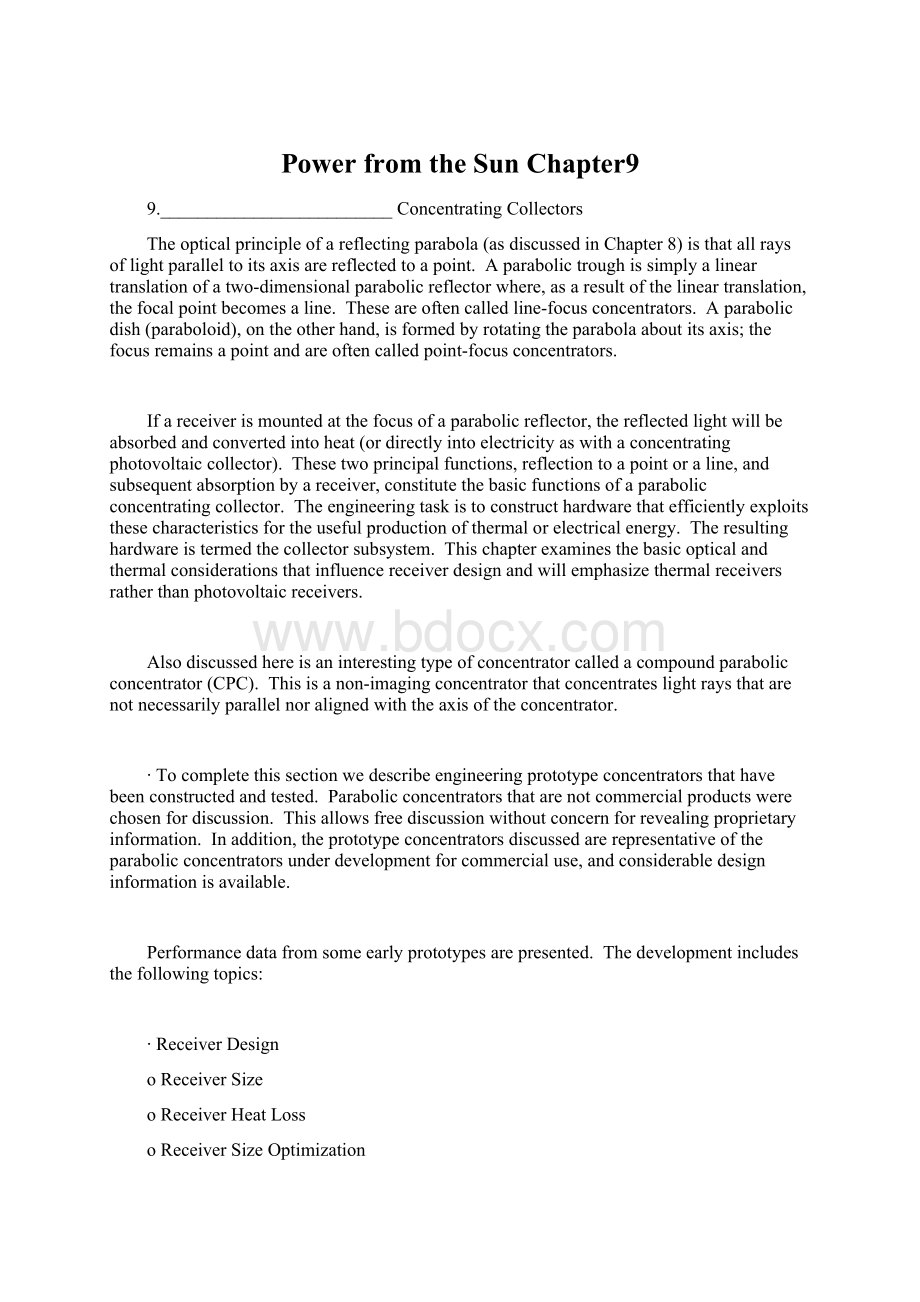Power from the Sun Chapter9.docx
《Power from the Sun Chapter9.docx》由会员分享,可在线阅读,更多相关《Power from the Sun Chapter9.docx(59页珍藏版)》请在冰豆网上搜索。

PowerfromtheSunChapter9
9._________________________ConcentratingCollectors
Theopticalprincipleofareflectingparabola(asdiscussedinChapter8)isthatallraysoflightparalleltoitsaxisarereflectedtoapoint. Aparabolictroughissimplyalineartranslationofatwo-dimensionalparabolicreflectorwhere,asaresultofthelineartranslation,thefocalpointbecomesaline. Theseareoftencalledline-focusconcentrators. Aparabolicdish(paraboloid),ontheotherhand,isformedbyrotatingtheparabolaaboutitsaxis;thefocusremainsapointandareoftencalledpoint-focusconcentrators.
Ifareceiverismountedatthefocusofaparabolicreflector,thereflectedlightwillbeabsorbedandconvertedintoheat(ordirectlyintoelectricityaswithaconcentratingphotovoltaiccollector). Thesetwoprincipalfunctions,reflectiontoapointoraline,andsubsequentabsorptionbyareceiver,constitutethebasicfunctionsofaparabolicconcentratingcollector. Theengineeringtaskistoconstructhardwarethatefficientlyexploitsthesecharacteristicsfortheusefulproductionofthermalorelectricalenergy. Theresultinghardwareistermedthecollectorsubsystem. Thischapterexaminesthebasicopticalandthermalconsiderationsthatinfluencereceiverdesignandwillemphasizethermalreceiversratherthanphotovoltaicreceivers.
Alsodiscussedhereisaninterestingtypeofconcentratorcalledacompoundparabolicconcentrator(CPC). Thisisanon-imagingconcentratorthatconcentrateslightraysthatarenotnecessarilyparallelnoralignedwiththeaxisoftheconcentrator.
∙Tocompletethissectionwedescribeengineeringprototypeconcentratorsthathavebeenconstructedandtested. Parabolicconcentratorsthatarenotcommercialproductswerechosenfordiscussion. Thisallowsfreediscussionwithoutconcernforrevealingproprietaryinformation. Inaddition,theprototypeconcentratorsdiscussedarerepresentativeoftheparabolicconcentratorsunderdevelopmentforcommercialuse,andconsiderabledesigninformationisavailable.
Performancedatafromsomeearlyprototypesarepresented. Thedevelopmentincludesthefollowingtopics:
∙ReceiverDesign
oReceiverSize
oReceiverHeatLoss
oReceiverSizeOptimization
∙CompoundParabolicConcentrators(CPC)
∙PrototypeParabolicTroughs
oSandiaPerformancePrototypeTrough
∙PrototypeParabolicDishes
oShenandoahDish
oJPLPDC1
∙OtherConcentratorConcepts
oFixed-MirrorSolarCollector(FMSC)
oMovingReflectorStationaryReceiver(SLATS)
oFixed-MirrorDistributedFocus(FMDF)(sphericalbowl)
∙PrototypePerformanceComparisons
Specialnotetothereader:
Theprototypehardwaredescribedinthesectionsbelowrepresentsthestate-of-the-artinthe1970´sandearly1980´s. Forupdatesoncurrentstatusofsolarconcentratorhardware,thereaderisreferredtothewebsiteofTheSunLab(combinedeffortsofSandiaNationalLabsandtheNationalRenewableEnergyLaboratorywebsite:
http:
//www.energylan.sandia.gov/sunlab/overview.htm andtheInternationalEnergyAgencywebsite:
http:
//www.solarpaces.org/csp_technology.htm. Readersarealsoencouragedtoaccessthewebsitesofdifferenthardwaremanufacturers.
9.1 ReceiverDesign
Thejobofthereceiveristoabsorbasmuchoftheconcentratedsolarfluxaspossible,andconvertitintousableenergy(usuallythermalenergy). Onceconvertedintothermalenergy,thisheatistransferredintoafluidofsometype(liquidorgas),thattakestheheatawayfromthereceivertobeusedbythespecificapplication.
Thusfarwehaveconcentratedourattentiononreflectionofincidentsolarenergyandnotbeenconcernedwiththegeometryofthereceiver. Therearebasicallytwodifferenttypesofreceivers-theomnidirectionalreceiverandthefocalplanereceiver.
Ratherthandealincompletegeneralityandtalkaboutthemanypossibletypesofreceiversthatcouldfallintothesetwocategories,wediscussonlytwowidelyusedreceivers,thelinearomnidirectionalreceiverandthepointcavityreceiver. Thiswillnotartificiallylimittheapplicabilityofthedevelopmentofthefollowingparagraphsbutwillprovideanicefocustothediscussion.
Figure9.1isasphotographofalinearomnidirectionalreceiverusedwithparabolictroughs. Itconsistsofasteeltube(usuallywithaselectivecoating;seeChapter8)surroundedbyaglassenvelopetoreduceconvectionheatlosses. Asthename´omnidirectional´implies,thereceivercanacceptopticalinputfromanydirection.
Figure9.1 Linearomnidirectionalreceiver,(a)photographofoperationalreceiver;(b)sketchofreceiverassemblycross-section. CourtesyofSandiaNationalLaboratories.
Figure9.2isasketchofacavityreceiver. Thisisclearlynotanomnidirectionalreceiversincethelightmustenterthroughthecavityaperture(justinfrontoftheinnershieldforthisreceiver)tobeabsorbedonthecavitywalls(coiledtubesinthiscase).
Figure9.2 Cavity(focalplane)receiver. CourtesyofSandiaNationalLaboratories.
Typically,theplaneofthecavityapertureisplacednearthefocusoftheparabolaandnormaltotheaxisoftheparabola. Thussuchareceiverissometimescalledafocalplanereceiver. Althoughthecavitycouldbelinearandthususedwithaparabolictrough,acavityreceiverismostcommonlyusedwithparabolicdishes. Figure9.3isaphotographofthissameparabolicdishcavityreceiver.
Figure9.3 PhotographlookingintothecavityapertureofthereceiverofFigure9.2.CourtesyofSandiaNationalLaboratories
9.1.1 ReceiverSize
OmnidirectionalReceivers-TheappropriatesizeforanomnidirectionalreceiverwasdevelopedinChapter8. ThediameterofatubereceiverisΔrasdefinedinEquation(8.44)(and2r1 asshowninFigure9.1b). Areceiverofthissizeinterceptsallreflectedradiationwithinthestatisticalerrorlimitsdefinedbyn. Thisequationisreproducedhereasanaidtothereader.
(8.44)
wherepistheparabolicradius,nthenumberofstandarddeviations(i.e.definingthepercentofreflectedenergyintercepted),andσtot theweightedstandarddeviationofthe beamspreadangleforallconcentratorerrors,asdevelopedinSection8.4anddefinedbyEquation(8.43).
Aswillbedescribedbelow,thevalueofn(i.e.thenumberofstandarddeviationsofbeamspreadinterceptedbyareceiverofsizeΔr),isdeterminedinanoptimizationprocessbasedonbalancingtheamountofinterceptedradiationandamountofheatlossfromthereceiver. Putinsimplifiedterms,alargerreceiverwillcapturemorereflectedsolarradiation,butwillloosemoreheatduetoradiationandconduction.
CavityReceivers-Theappropriatesizeofthecavityopening(i.e.itsaperture)isdeterminedusingthesameopticalprinciplesusedinthedevelopmentofEquation(8.44)butthenprojectingthereflectedimageontothefocalplanewherethereceiveraperturewillbelocated.
IfthebeamspreadduetoerrorsissmallinFigure9.4,theanglesα andβ areapproximately90degrees. Thustheprojectionoftheimagewidthontothefocalplaneis
(9.1)
SubstitutionintoEquation(8.44)yields
(9.2)
Figure9.4 Sizingofcavityapertureconsideringbeamspreadingduetoerrors.
SelectionofConcentratorRimAngle-Itisinterestingtostudytheimpactofreceivertypeonthepreferredconcentratorrimangle. Thewholeideaofaconcentratoristoreflectthelightenergyincidentonthecollectorapertureontoassmallareceiveraspossibleinordertominimizeheatloss.
Figure9.5isaplotoftherelativeconcentrationratiosforbothcavitiesandomnidirectionalreceiversasafunctionofrimangle. TheconcentrationratioforthetwoconceptsistheratioofthecollectorapertureareadividedbytheareaoftheimageatthereceiverasdefinedbyEquations(8.44)and(9.2),respectively. Notethatthecurvefortheomnidirectionalreceiverincreasesuniformlyupto90degrees,whereasthecurveforthefocalplanereceiverincreasesuptoarimangleofabout45degreesandthendecreasesbecauseofthecosineψ terminthedenominatorsinEquations(9.9)and(9.10).
Figure9.5 Variationofgeometricconcentrationratiowithrimangle.
Theimpactofthisphenomenonisthatmostconcentratorswithanomnidirectionalreceiverhaverimanglesnear90degrees. Ontheotherhand,concentratorswithfocalplanereceivershaverimanglesnear45degrees. Thecurvesshowonlytrendsforeachreceivertype,andtheirmagnituderelativetoeachotherasshowninFigure9.5isnotcorrect.
9.1.2 ReceiverHeatLoss
LinearOmnidirectionalReceivers-TheheatlossratefromalinearomnidirectionalreceiverofthetypeshowninFigure9.1isequaltotheheatlossratefromtheoutsidesurfaceoftheglasstube. Thiscanbecalculatedasthesumoftheconvectiontotheenvironmentfromtheglassenvelopeplustheradiationfromtheglassenvelopetothesurroundings.
(9.3)
where:
hg=convectiveheat-transfercoefficientatoutsidesurfaceofglass
envelope(W/m2°C)
Ag=outsidesurfaceofglassenvelope(m2)
Tg=outsidesurfacetemperatureofglassenvelope(K)
Ta=ambienttemperature(K)
σΒ =Stefan-Boltzmannconstant(5.6696×10-8W/m2K4)
ε g=emittanceoftheglass
Fga=radiationshapefactor
Ts=skytemperature(K)(typicallyassumedtobe6Kelvinslowerthanambienttemperature)(Treadwell,1976)
Ifallthevariablescanbeeval